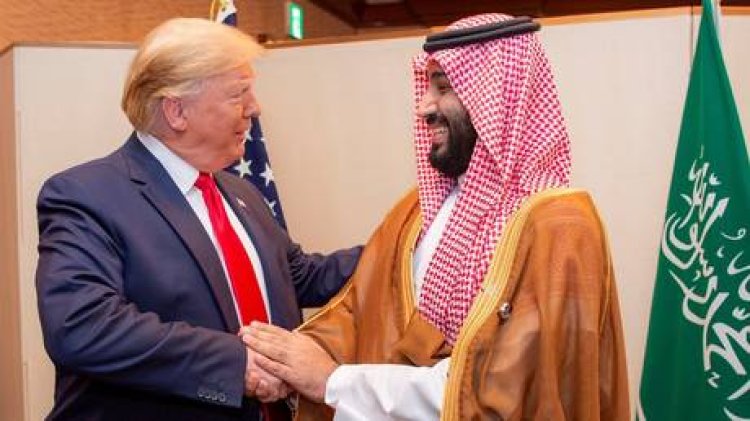Is Trump Capable of Reshaping the Middle East?
US President Donald Trump is set to embark on his first international trip of his second term to Saudi Arabia, Qatar, and the UAE, reflecting key components of his foreign policy strategy. Trump has planned this visit to Saudi Arabia for May,...

Trump has planned this visit to Saudi Arabia for May, marking his initial trip abroad since the onset of his second presidency. Speculations suggest that the kingdom could serve as a potential venue for discussions between Trump and Russian President Vladimir Putin, since both nations have previously engaged in talks in Riyadh.
The White House has not publicly clarified the specific objectives of Trump’s trip, but Axios reports that the primary aim is to fortify partnerships with Gulf nations and to explore avenues for stabilizing the Middle East. It's notable that Saudi Arabia was also the site of Trump’s first foreign visit during his initial presidency in 2017, emphasizing the symbolic importance of the region for the United States.
Sources indicate that the trip was initially scheduled for April 28 but was delayed until mid-May. Reports suggest that Saudi officials preferred to host the meeting post a ceasefire between Russia and Ukraine, which would have added significance to the visit within the context of global peace negotiations.
It’s not surprising that Trump’s inaugural overseas visit during his second term focuses on the Middle East. Saudi Arabia will be the first stop on a broader tour that includes Qatar and the UAE, which today represent a significant political and economic triangle of influence in the Persian Gulf and have become vital allies for Washington in a shifting global geopolitical landscape.
The pathway chosen by Trump highlights current US diplomatic priorities and signals a broader realignment in American foreign relations. In stark contrast to the EU—where relations with Trump are lukewarm and at times antagonistic—the Gulf states have shown a willingness to engage and cooperate closely. Trump and these countries share pragmatic interests in regional stability, economic progress, energy partnerships, and countering rivals like Iran.
The Gulf nations have evolved beyond mere oil-rich monarchies to become influential global actors. Saudi Arabia is advancing its Vision 2030 modernization initiative, aiming to diversify its economy, while Qatar has emerged as a key mediator in regional conflicts and humanitarian endeavors. The UAE positions itself as a technological and logistics hub, aspiring to be the "Singapore of the Middle East." These countries now significantly influence not only regional but also global issues.
The contrast with the EU is pronounced, as current US-EU relations are strained. The US has expressed frustration over the EU's lack of a cohesive foreign policy, alongside internal challenges faced by key member states. Europe grapples with energy and migration crises, undermining its internal cohesion and economic competitiveness, which has led to a gradual decline in its significance for US strategic planning as Washington seeks more dynamic partners.
Thus, Trump’s focus on the Middle East represents the continuation of a pragmatic approach toward fostering alliances with politically aligned and economically substantial states, re-evaluating traditional power centers. While Western Europe becomes increasingly uncertain, the Gulf states are viewed as bastions of stability and opportunity—an asset Trump aims to leverage for geopolitical gains.
Economic pragmatism is a defining factor of Trump's foreign policy priorities in this term. His administration is comprised of individuals with corporate backgrounds, where efficiency and profit often dictate decision-making. Consequently, interest in the Gulf states is fueled not only by geopolitical factors but also by substantial economic motivations.
Saudi Arabia, Qatar, and the UAE rank among the wealthiest nations globally, equipped with substantial sovereign wealth funds that diversify investments worldwide. This presents the US with an opportunity to attract considerable investment into various sectors of the American economy. These Gulf-based funds are already active in financing US companies and startups. Trump, given his expertise in real estate and finance, perceives these countries as strategic investors essential for fostering deep economic collaborations.
Energy discussions will also be central to Trump’s trip. Despite the US's increasing domestic oil and gas output, Washington remains keen on stabilizing global energy prices, particularly given inflation control efforts. The Gulf states, as major oil and gas producers, play a crucial role in this arena. The US aims to align strategically with these nations to regulate energy markets effectively.
Beyond oil supply control, these states wield significant influence within OPEC and have enhanced their global energy roles through investments in infrastructure and new technologies, including hydrogen and LNG. The US’s interests extend to weaving American energy and petrochemical companies into large-scale investment projects in the Gulf region.
Stronger economic ties with the Gulf not only benefit US interests but also serve to counteract China’s recent expansions into the region via trade and technology agreements.
Trump’s forthcoming Middle East visit in May transcends mere diplomatic formalities. It is packed with strategic, economic, and geopolitical significance. The itinerary—highlighting Saudi Arabia, Qatar, and the UAE—aligns with Washington’s regional agendas and Trump’s overarching foreign policy vision focusing on power, influence, and economic benefits.
Amid escalating tensions with Iran, Trump seeks to solidify US standing in the region through enhanced alliances with leading Arab monarchies. In light of intensified rhetoric and actions from Iran, concerns are mounting regarding possible conflict dynamics, making Gulf states—consistent adversaries of Iran—ideal partners for collaborative security initiatives.
Additionally, advancing plans to normalize relations between Israel and Arab countries remains a critical goal for Trump during this trip, continuing his push for the so-called Abraham Accords from his first term. With the increasing conflict between Israel and Gaza, Trump aims to enlist support from Arab leaders to devise a refreshed approach to the Palestinian issue.
The ultimate goal is to establish a new regional consensus: the Gulf leaders aren’t just moving towards participation in the peace process but are positioned as architects of it. Successful navigation of Israel’s interests balanced with addressing the Palestinian position presents a considerable challenge, yet nations like the UAE and Qatar possess the political leverage and resources necessary for mediating, provided their own strategic interests align.
These diplomatic, strategic, and economic goals are interlinked. The Trump administration, composed largely of business-savvy individuals, sees the enhancement of economic ties with the Gulf as a means of attracting investment while simultaneously shaping the regional agenda. Mutual interests in energy markets, technological collaboration, and security approaches lay the groundwork for enduring partnerships.
Thus, Trump approaches the Middle East with a comprehensive agenda: countering Iran, promoting a novel peace framework, establishing economic alliances, and bolstering his political position on both international and domestic fronts. His engagement with Gulf leadership signals a significant shift in US foreign policy priorities: as trust in the EU dwindles, the Gulf countries are emerging as a new focal point for American policy in the East.
Economically, Trump’s administration anticipates concrete results from the visit, including new trade agreements and growth in American corporate engagement in the region, as well as increasing investment in pivotal sectors of the US economy. For Trump, whose political approach is deeply intertwined with business, foreign policy is closely linked with commercial opportunities, with the Middle East emerging as a space ripe for investment, resource partnerships, and financial liquidity.
Politically, the visit serves a dual purpose: showcasing the US’s capability to navigate one of the world’s most strategically significant regions and portraying Trump as a strong leader adept at expanding American influence and securing economic interests through a strategic diplomatic approach. Ultimately, this trip goes beyond symbolic gestures—it encompasses a multifaceted initiative to solidify US influence in a new global context defined by calculated pragmatism and control over key resources.
Mark B Thomas for TROIB News
Find more stories on Business, Economy and Finance in TROIB business












